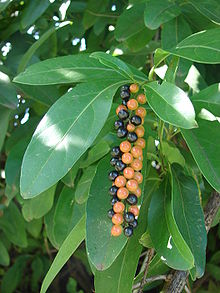- Citharexylum
-
Citharexylum 
C. caudatum Scientific classification Kingdom: Plantae (unranked): Angiosperms (unranked): Eudicots (unranked): Asterids Order: Lamiales Family: Verbenaceae Genus: Citharexylum
L.Type species Citharexylum spinosum
(L.)[1]Species See text
Citharexylum is a genus of flowering plants in the verbena family, Verbenaceae.[2] It contains 70 to 100 shrub and tree species[3] commonly known as Fiddlewoods or Zitherwoods.[4] They are native to the Americas, ranging from southern Florida and Texas in the United States to Argentina. The highest diversity occurs in Mexico and the Andes.[5] The generic name is derived from the Greek words κιθάρα (kithara), meaning "lyre", and ξύλον (xylon), meaning "wood," referring to the use of the wood in the sounding boards of string instruments.[6][7] Several species, especially C. caudatum and C. spinosum, are cultivated as ornamentals.[3]
Contents
Selected species
- Citharexylum berlandieri B.L.Rob. – Berlandier's Fiddlewood, Tamaulipan Fiddlewood
- Citharexylum brachyanthum (A.Gray) A.Gray – Boxthorn Fiddlewood, Mexican Fiddlewood
- Citharexylum caudatum L. – Juniper Berry
- Citharexylum gentryi Moldenke
- Citharexylum montevidense Moldenke
- Citharexylum myrianthum Cham.
- Citharexylum poeppigii Walp.
- Citharexylum spinosum L. – Spiny Fiddlewood
- Citharexylum tristachyum Turcz. – Threespike Fiddlewood[8][9]
Formerly placed here
- Rhaphithamnus spinosus (Juss.) Moldenke (as. C. cyanocarpum Hook. & Arn.)[8]
References
- ^ "Citharexylum L.". TROPICOS. Missouri Botanical Garden. http://tropicos.org/Name/40009390. Retrieved 2010-01-25.
- ^ "Genus: Citharexylum L.". Germplasm Resources Information Network. United States Department of Agriculture. 2005-01-29. http://www.ars-grin.gov/cgi-bin/npgs/html/genus.pl?2635. Retrieved 2009-09-24.
- ^ a b Whistler, W. Arthur (2000). Tropical Ornamentals: a Guide. Timber Press. pp. 128–130. ISBN 9780881924756.
- ^ Quattrocchi, Umberto (2000). CRC World Dictionary of Plant Names: A-C. CRC Press. p. 544. ISBN 9780849326752. http://books.google.com/books?id=esMPU5DHEGgC&.
- ^ Aymard, Gerardo A.; Ricardo M. Rueda (Summer 1997). "A New Species of Citharexylum (Verbenaceae) from Ecuador". Novon 7 (2): 95–97. JSTOR 3392177.
- ^ Burke, Don (2005). The Complete Burke's Backyard: the Ultimate Book of Fact Sheets. Murdoch Books. p. 116. ISBN 9781740457392. http://books.google.com/books?id=MMMjW6AuzHAC&.
- ^ Austin, Daniel F. (2004). Florida Ethnobotany. CRC Press. pp. 217–219. ISBN 9780849323324. http://books.google.com/books?id=eS7lX_rC3GEC.
- ^ a b "GRIN Species Records of Citharexylum". Germplasm Resources Information Network. United States Department of Agriculture. http://www.ars-grin.gov/cgi-bin/npgs/html/splist.pl?2635. Retrieved 2010-09-13.
- ^ "Citharexylum". Integrated Taxonomic Information System. http://www.itis.gov/servlet/SingleRpt/SingleRpt?search_topic=TSN&search_value=32147. Retrieved 25 January 2010.
External links
 Media related to Citharexylum at Wikimedia Commons
Media related to Citharexylum at Wikimedia Commons  Data related to Citharexylum at Wikispecies
Data related to Citharexylum at Wikispecies
This Verbenaceae article is a stub. You can help Wikipedia by expanding it.
